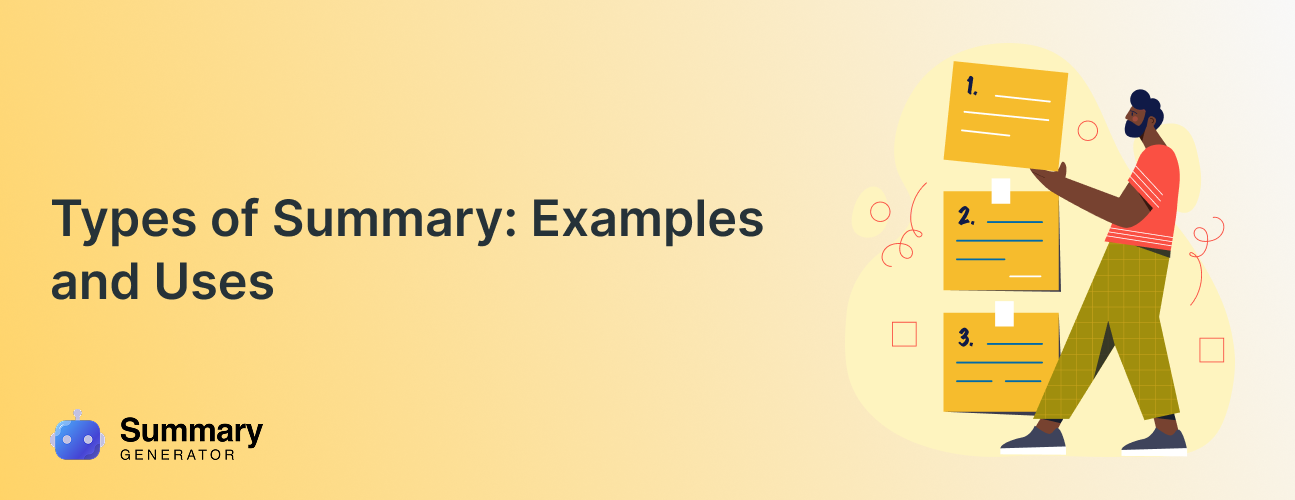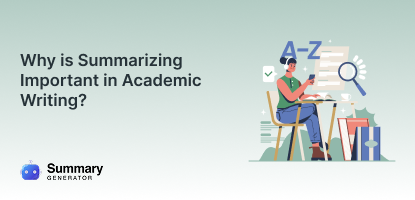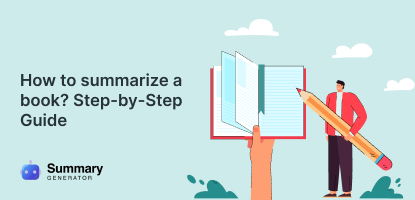Summary writing is undoubtedly a crucial skill to master. Almost everyone, including students, teachers, researchers, content creators, and even job-holders, needs to write summaries for various purposes. That’s why they must know how to summarize an article or any type of content effectively.
They also know which type of summary suits well according to the context. Otherwise, they might make mistakes that affect the quality of content. In this blog, we will talk about different types of summaries, their use cases, and examples.
Let’s get started!
Descriptive Summary
First of all, we have descriptive summaries. This type of summary is used in academia, where students and researchers outline the content and structure of a document without adding personal opinions.
A descriptive summary identifies the topics covered in the study, how they are organized, and what information is included. Unlike various other types, we don’t conclude or evaluate the source in this.
Key Features
- Lists main topics without opinion
- Follows the original structure
- Neutral in tone
- Omits data interpretation
Use Cases
- Academic book introductions
- Research articles
- Library catalog entries
- Annotated bibliographies
- Initial research scans
Example
A study explores the impact of social media on student productivity. It examines usage patterns, sleep habits, and academic performance across five universities over two academic years.
Summary
This paper analyzes social media usage, sleep behavior, and academic outcomes in students from five universities.
Executive Summary
An executive summary condenses the critical points of a longer report or proposal. It is used to ensure quick understanding and faster decision-making. This type of summary includes multiple things, like essential findings, conclusions, and recommendations. However, in executive summaries, we skip all the less relevant details. This summary type is generally strategic, informative, and action-focused.
Key Features
- Summarizes key points, outcomes, and conclusions
- Includes data highlights
- Omits unnecessary details
- Written in clear, concise language
- Prioritizes decision-making relevance
Use Cases
- Business proposals
- Project reports
- Market analysis summaries
- Government and corporate policy briefs
Example
A 45-page market analysis covers regional trends, sales growth opportunities, competitor performance, and customer behavior in the Southeast Asian electric vehicle industry. Data from Q1 to Q4 is analyzed and benchmarked.
Summary
Southeast Asian EV sales will grow 15% annually over five years, led by Indonesia and Vietnam, with key local production and digital campaigns opportunities.
Synoptic Summary
A synoptic summary combines information from multiple sources to provide a comparative or thematic overview. Rather than focusing on a single document, it integrates key points from different authors or studies. Moreover, it captures agreements, contrasts, and recurring ideas across sources. This makes it ideal for comprehensive reviews, particularly when analyzing trends or ongoing debates.
Key Features
- Integrates multiple sources
- Identifies similarities and differences
- Often used in literature reviews
- Highlights recurring themes
- Avoids focusing on a single opinion
Use Cases
- Literature reviews
- Thematic research papers
- Meta-analyses
- Policy comparison briefs
Example
Study A focuses on how online learning increases accessibility. Study B discusses learner engagement in virtual classrooms. Study C examines cost-effectiveness in digital education models.
Summary
Online learning improves accessibility and cost efficiency, though engagement levels vary depending on course design.
Abstract
An abstract provides a compact but complete snapshot of a study, including its purpose, methodology, main findings, and conclusion. It’s very common, in fact, integral to research papers, academic assignments, theses, and dissertations. Abstracts help readers quickly assess whether a paper is relevant. Contrary to other types of summaries, it appears at the beginning of scholarly articles and functions as a standalone summary for indexing and database searches.
Key Features
- Includes a research question or problem
- Briefly describes methods
- Summarizes findings
- Concludes with key takeaways
- Typically 150–250 words
Use Cases
- Journal articles
- Conference papers
- Dissertations
- Scientific reports
Example
A clinical trial investigates the impact of a new drug on reducing blood pressure in adults aged 40–60. The double-blind study involved 300 participants over 12 weeks. Final results showed a statistically significant reduction in systolic readings.
Summary
The study found that MedX-21 significantly lowered systolic blood pressure in middle-aged adults over 12 weeks.
Evaluative Summary
An evaluative summary combines a traditional summary with critical commentary. It outlines the content while offering judgments about the work’s value, reliability, or contribution. This format is common in reviews or critiques where both comprehension and evaluation are needed. Evaluative summaries go beyond what is said to address how well it was said.
Key Features
- Combines summary and evaluation
- Highlights strengths and weaknesses
- Offers a brief critique or assessment
- May include author bias or limitations
- Provides context or relevance
Use Cases
- Book and article reviews
- Critiques in academic journals
- Editorial commentary
- Media and film reviews
Example
A journal article introduces a new method for bilingual education using multimedia. It outlines theoretical foundations, includes preliminary data, and suggests future research. However, the sample size is limited.
Summary
The article proposes a creative bilingual teaching method with solid theory but limited empirical support.
Precis
A precis condenses a passage while preserving its tone, logical order, and proportionality. Unlike summaries that focus mainly on content, a precis retains the voice and style of the original. It avoids interpretation and only includes what’s essential. A precis is often used in academic or rhetorical settings; it trains writers to be both concise and faithful to the original.
Key Features
- Extremely concise
- Reflects tone and style
- Maintains proportion and structure
- Omits repetition and examples
- Avoids interpretation or opinion
Use Cases
- Summarizing speeches
- Academic essay assignments
- Debates and oratory prep
- Report condensation for the study
Example
Over the past decade, climate scientists have reported increased polar melting and rising sea levels. Environmental reports echo the findings’ urgency, pressing for faster global intervention.
Summary
Climate experts and environmental groups stress urgent action due to rising sea levels and melting ice caps.
Informative Summary
An informative summary covers all the main points of the source material in a balanced and thorough way. It does not evaluate or interpret the content, but it includes essential facts, arguments, and conclusions. This type of information is helpful when the goal is to inform someone who won’t read the full text. Informative summaries aim for completeness without excess detail.
Key Features
- Complete yet concise
- Includes all main ideas
- Omits commentary
- Structured logically
- Covers beginning to end
Use Cases
- Textbook chapter summaries
- Study notes
- User manuals
- Business training material
Example
A textbook chapter explains the circulatory system, detailing how the heart pumps blood through arteries and veins. It describes oxygen exchange, carbon dioxide removal, and how nutrients circulate. Diagrams support each central concept.
Summary
The circulatory system moves blood through the body, supplying oxygen and nutrients while removing waste.
Tips to Write a Summary
Finally, have a look at some practical tips for writing a summary with precision.
- Know the Purpose: First of all, know the purpose of your writing. It can help you choose the right summary type and tone.
- Read the Text Thoroughly: You must read the entire text to understand the context and find out the key details and information.
- Use Unique Words: Whether you are writing a summary for yourself or someone else’s study, make sure not to copy and paste the text. Instead, write it in your own words.
- Use an Advanced Summary Maker: To write a summary, you can get some help from an online summary maker. It can precisely and quickly create a well-refined summary according to your needs.
Conclusion
Summaries serve different purposes and audiences. Therefore, we must understand different types of summaries, their features, and use cases. That’s how we can write effective summaries without confusing readers or missing out on important points. Once you understand all types of summaries, you can easily match the summary type to your purpose, choose the correct format, and write with precision. Eventually, making your work more appropriate and impactful.



